The Ainu and The Kennewick Man
Posted by: Loren Coleman on December 8th, 2008
Loren is still on the road, trying to keep in contact remotely. In the meantime, guest blogger Brent Swancer continues his examination of the Ainu, with part II of his contribution from Saturday. If you recall, he left us noting that the focus of the debate swirling around one theory on the origins of the Ainu involves a curious piece of fossil evidence called the Kennewick Man (which was studied by a team that included paleoanthropologist Grover Krantz before his death).
The Ainu and the Kennewick Man
by Brent Swancer
December 8, 2008.
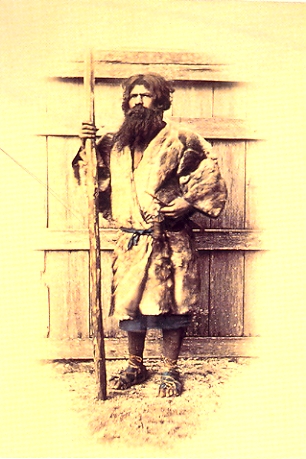
The Kennewick Man, also sometimes referred to as the Richland Man, is a skeleton which was accidentally found at the Lake Wahulla section of the Columbia River in Kennewick, Washington on July 28, 1996. The skeleton was in remarkably good condition, missing only the sternum and some bones in the hands and feet.
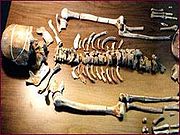
Upon examination, it was found that the skeleton lacked many distinctive features found in Native Americans, and exhibited some Caucasian features as well. In addition to features of the skull and bones, the condition of the teeth suggested a diet different from the Native Americans. For these reasons, it was thought that the remains were perhaps that of an early European explorer, however the mystery would only deepen upon further analysis.
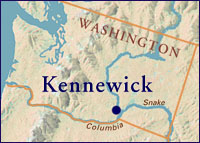
Through preliminary radio carbon dating, it was found that the remains were around 9,000 years old. Also, a projectile tip of a type used from around 8,500 BP to 4,500BP was found lodged in the hip. It seemed that this was no European explorer, but rather a stone age individual with characteristics unlike the later Native Americans. Anthropologists and paleontologists rushed in to do more detailed examinations and try to determine the nature of these mysterious remains. Upon comparing the remains to 18 modern populations of humans, it was determined that the ancestry most closely resembled that of the Ainu.

The study of the Kennewick Man remains has long been embroiled in controversy. The remains were originally taken possession of by the U.S. Army Corps of engineers, who own the land on which the remains were found, however this was immediately challenged in court by the NAGPRA (Native American Graves Protection and Repatriation Act). NAGPRA states that any human remains found on federal lands that are found to be affiliated with a Native tribe can be claimed by that tribe.
Several tribes claimed the remains as their own and demanded their return for a proper burial. This was quickly opposed by a group of archeologists and anthropologists who claimed that NAGPRA did not apply in this case. And so the long legal battles surrounding the Kennewick man started, often holding up studies and even bringing research on the remains to a halt. Examination was halted in 1996 due to court battles and debates with Native tribes, only to resume again in 1998.
Scientific studies that were done on the skeleton from 1998 to 2000 were frequently dogged by legal woes, and it wasn’t until 2002 that a federal court ruled that NAGPRA did not apply to the remains as a cultural link was not met, and this allowed scientists better access to the remains. This ruling was upheld again in 2004, but the firestorm of controversy and legal motions are far from over. Currently, the skeleton is being held at the Burke Museum at the University of Washington, and is legally designated as the property of the U.S. Army Corps of Engineers.
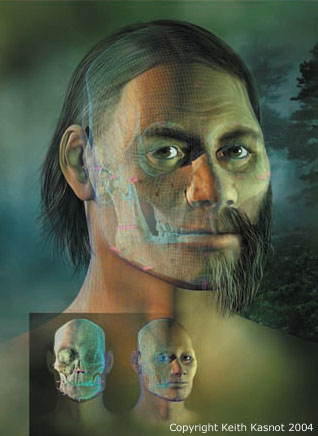
To date, despite the legal controversy, the Kennewick Man remains have been physically examined on various occasions using standard scientific methods and techniques, and some things have been gleaned from it. It is known that the man was between 45 and 55 years old, around 5’9″ in height, was muscular, and had received various injuries that appear to have healed before death. In addition, evidence suggests that the body was deliberately buried rather than left exposed to the elements. Yet the mystery of who this man was or where he came from remains as mysterious as ever. In 2006, results of studies performed on the remains in 2005 supported the earlier notion that these remains closely matched features found in the Ainu people.
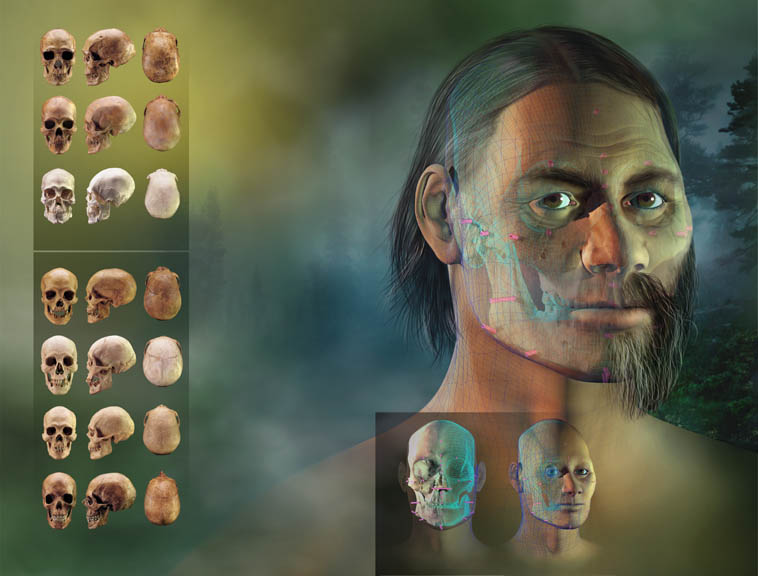
So is it possible that Ainu were some of the first humans to inhabit North America? The theory certainly has its share of detractors. Some insist that there are not enough samples to make any assumptions on the origins of the remains. They are quick to point out that the physical differences of a single specimen don’t mean anything in the larger picture and therefore the Kennewick Man is useless as evidence of anything. Others point to the greater physical diversity between individuals in remains dating over 8,000 years old, or even point to the blurry lines of race to begin with. It could be argued that human populations are not unambiguous or clearly separated biological groups so therefore any divisions made between biological populations are subjective and arbitrary, especially when looking at 9,000 years old bones.
The debate goes on, but the essential mystery remains. Who was Kennewick man? Further analysis of the remains may yield more answers, but if it is indeed the skeleton of an Ainu as speculated, then this would shake to the core our current conventional understanding of how and by whom the continent was first settled.
^^^^^^^^^^^^^^^^^^^^^^
Footnote from Loren:
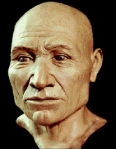
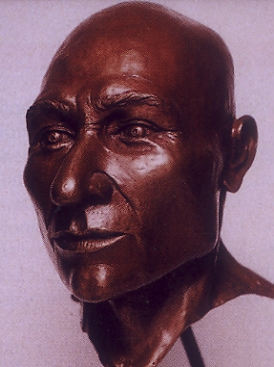
One of the first forensic reconstructions from the skull of the Kennewick Man looked extremely familiar to those who viewed it soon after its completion.

Very familiar.
About Loren Coleman
Loren Coleman is one of the world’s leading cryptozoologists, some say “the” leading living cryptozoologist. Certainly, he is acknowledged as the current living American researcher and writer who has most popularized cryptozoology in the late 20th and early 21st centuries.
Starting his fieldwork and investigations in 1960, after traveling and trekking extensively in pursuit of cryptozoological mysteries, Coleman began writing to share his experiences in 1969. An honorary member of Ivan T. Sanderson’s Society for the Investigation of the Unexplained in the 1970s, Coleman has been bestowed with similar honorary memberships of the North Idaho College Cryptozoology Club in 1983, and in subsequent years, that of the British Columbia Scientific Cryptozoology Club, CryptoSafari International, and other international organizations. He was also a Life Member and Benefactor of the International Society of Cryptozoology (now-defunct).
Loren Coleman’s daily blog, as a member of the Cryptomundo Team, served as an ongoing avenue of communication for the ever-growing body of cryptozoo news from 2005 through 2013. He returned as an infrequent contributor beginning Halloween week of 2015.
Coleman is the founder in 2003, and current director of the International Cryptozoology Museum in Portland, Maine.










Great report, MM. Particularly fine job at explaining the native graves issue. I’m gratified to know that the law eventually sided with the physical anthropologists in this instance.
All this means is that the Ainu had the capability to get here, even if this one skeletal remain happens to be the only one to do so. He could have been an explorer or a poor fisherman blown off course. Given the position of Japan in the Pacific, it isn’t a long grasp to say that someone followed the shoreline north, noticed more shoreline on the other side of the water and followed that shoreline down. Given we really don’t know just how advanced these people were at any time, we really can’t make any statements about where they actually originated, or where they did live in the past. Just how many of the South Pacific islands were home to these people before the ancestors of the people living there today drove them out or killed them? Hard to say. Are there any stories about such events? Does anyone know?
I was under the impression that the multiple-settlement theories for the Americas were more and more firmly established in spite of facing opposition from the Politically Correct in academia?
The PC position being that Western Hemisphere indigenes had to have developed everything independently, apparently being too stupid to learn anything from the occasional Polynesian contact or Irish monk on the White Martyrdom, that Melanesians could not have navigated to South America, that the Red Paint people could not have followed the auk and seals along the edges of the ice to North America, and so on. This being in counter-point to a previous supposed view that the locals were too stupid to have invented anything on their own.
I would suggest that there is nothing stupid about the locals, and that reality is probably far more complex than we know.
Very good article, thanks Brent!
By the way, the footnote is more than compelling… I’m pretty sure that Kennewick Man was a time-traveling starfleet captain, no question about that!
Brent,
Per usual, a well-researched and well-reasoned article.
I am a little perplexed by your conclusion that if Kennewick man “is indeed the skeleton of an Ainu as speculated, then this would shake to the core our current conventional understanding of how and by whom the continent was first settled.” Don’t understand why it should.
The classic hypothesis (“Clovis First”), that the first Paleoindians in North America crossed the Beringia land bridge during the period of lowered sea levels during the ice age, then made their way southward through an ice-free corridor east of the Rocky Mountains in present-day western Canada as the glaciers retreated is rapidly losing support for a variety of reasons. It’s now widely thought that the first Paleoindians migrated south along the North American coastline in boats. As must other ensuing waves of Paleoindians.
So if the Ainu are today considered eastern-Asiatic in origin, with a sea-faring legacy, I just don’t see how the skeleton of a 9,000 year old Ainu or one of its ancestors found in North-west America would shake to the core 2008 archeological “conventional wisdom.”
But again, Brent, great stuff.
Excellent, as always. I’d forgotten about the possible Ainu link to Kennewick man, thanks for the info. You’ve told me more about the case in recent years than I had seen/heard before. Fascinating stuff.
I’m still curious as to the Haplogroup issue – is it listed anywhere which one the Ainu and Kennewick man belong too?
Hi
Super post really enjoyed it !
Thanks
Great article! Any theory related to “alternative history” or a anthropological mystery is fascinating to me.
Loren should enjoy this: There was a Star Trek episode in which Picard and the others traveled back in time because a head that looked exactly like Data had been uncovered in a cavern below San Francisco-a real out of place, out of time enigma.
A) The Kennewick Man, according to modern theories, is an out of place, and arguably out of time man (as Europeans weren’t suppose to be in the new world at this time).
B) Strangely, KM resembles Patrick Stewart who played Picard.
C) The above article was written by Brent (the actor who played Data is named Brent, also).
D) Finally, the Star Trek episode was named “Time’s Arrow”. Kennewick Man had a “projectile tip” in his hip–an arrow perchance?
Maybe a little bit of a stretch but kinda fun to look at the coincidences in a Fortean way.
Star Trek fans should be barred from forensic reconstructions.
Corrick- Well, one of the problems is that the origins of the Ainu are not completely understood. Another is that while they were good at seafaring, it is unclear whether they had the means for a transpacific voyage.
Also, I’m not archeologist, but it is my understanding that hypotheses on migrations to the New World are still in dispute and debated over. Through researching this, it seems the hypothesis of a seafaring migration to the New World is not a completely proven one accepted by consensus, and I’m not sure it could be considered “conventional wisdom” at this point. While the idea has made headway and has merit, there are still those that promote the ideas of land migrations in either a single or multiple waves, depending on the hypothesis.
In fact, there still seem to be some problems with the idea of a seafaring migration of the New World. For example, rising sea levels have meant that some areas of coastline that these ancient people would have followed are now submerged, making it difficult to find and excavate sites. I also understand there is a lack of hard physical evidence, partly due to this fact.
Seafaring migration seems like it is possible, and progress has been made on this idea, but conventional wisdom? I suppose The Kennewick man being Ainu in origin could actually feed more evidence to the seafaring migration hypothesis and in that sense, it would not be so earth shattering according to that hypothesis. However, it still seems to be open to some amount of debate amongst anthropologists and archeologists, and I don’t think it has been conclusively resolved.
Anyway, it certainly isn’t conventional wisdom that the Ainu made it to the new world, or what exactly their migrations and history are. Finding that an Ainu had made it to the New World at the time the bones are dated would be an exciting find, and the Kennewick Man could give us a new perspective on who populated North America and when, as well as the extent on Ainu migrations.
Uriah- The Haplogroup for the Ainu is Y chromosone Haplogroup D. This is the same Haplogroup shared by indigenous people of Tibet, the Jarawa and Onge people of the Andaman Islands, and some populations in mountainous central Asia such and Tajikistan. It should be noted though, that Haplogroup D is known for a good deal of geographic differentiation, and there are distinct subsets of Haplogroup D chromosones being found exclusively in some populations. So for example, Haplogroup D1 is found in Tibet, D2 is found in the Ainu, D3 amongst the peoples of Tajikistan and areas of central Asia, and D* in the Andaman Islanders.
There is also a portion of Ainu that belong to the Y chromosone Haplogroup C3, which is common among indigenous populations of Mongolia and the Russian far east.
Sorry if that was confusing on my first post. It is what I meant by “genetic evidence”, and in my effort to keep the article accessible to the layperson who might not know about Haplogroups, I failed to make the distinction. Sorry about that.
Thanks Mystery Man,
It looks like the Ainu were well traveled by the time they settled Japan, this would add credence to the idea that they made it to the New World.
I like these sorts of posts, keep’em coming!
I find certain claims about “political correctness” in academia to be curious, and certainly out of touch with anything current in anthropology and archaeology. Speaking as an archaeologist, I can say that while some ideas become entrenched, no one idea can be held steadfast against overwhelming amounts of data to the contrary (see the Clovis First argument). Up to a few years ago, Clovis First was still widely defended, but I would say the field of archaeology today is much more accepting of both a pre-Clovis occupation of North America and of multiple routes of populations. And the idea that it is “PC” to think that Native Americans were too “Stupid” to accept new technologies is just ridiculous on its face – perhaps someone is still fighting the culture wars of the late 1980s?
That being said, the problem with extrapolating anything from the Kennewick Man skeleton and applying it to populations is problematic, mainly because there’s only about a dozen or so North American skeletons as old or older than Kennewick Man. It’s generally accepted that there is some difference between the skeletal morphology of Paleoindians and later Native American populations, but because of the small data set, it’s hard to say whether the difference represents evolution of skull morphology or an influx of later populations. (as an aside, the small amount of human skeletal remains that can be reliably dated as ancient in North America can also be used as a point in the argument about the lack of fossil Sasquatch remains in North America – we know that people have been in the Americas for at least 14,000 years and probably for 20,000 years, but we only have a handful of skeletons, none of them older than 10,000 years!)
I myself favor the idea that North America has been visited several times over the last 10,000 years by various groups, but only a few managed to establish viable populations.
Thanks for all the posts, Mystery Man. Like several others here, I have long been fascinated by the Ainu and their origins. Personally, I find the link between the Ainu and the Jomon to be quite strong (Trash middens indicate identical food sources and lifestyle, style of houses are identical, etc.), and at the very least far stronger than between the Jomon and the Yayoi. As for their origins, I would suggest they are an amalgam of Mongoloid and Polynesian or Melanesian stock, although there’s been so much comingling with the modern Japanese that we may never know for certain.
The link between the Ainu and Native Americans may be even stronger than Kennewick Man, at least if we accept the notion that the Jomon were their predecessors or relatives. Studies of ancient pottery from the Valdivian culture in Ecuador and Peru have shown very strong links to Jomon pottery, and like them, the Valdivians were a maritime, coastal culture. Further, the Pericu of Baja California, who survived until the 1700’s, were noted as being both culturally and physically distinct from their clearly Amerindian neighbours. Studies of Pericu skulls just a few hundred years old strongly suggest a similarity to the Ainu, although I don’t know if their culture did, save that they were also a coastal people.
Mnynames- An argument can certainly be made that the Jomon and Ainu have a strong connection, but the extent of this connection is not completely known. There certainly seems to be more morphological similarity between the Jomon and Ainu than between the Ainu and Yayoi, however there are differences too. For example, one study I read mentioned that when measured based on 18 cranial traits, Ainu skulls differed significantly from Jomon skulls on 7 of these traits. These seven traits were found to be more similar to the Northeast Asian Okhotsk people. So it seems possible the Ainu are in some intermediate position in this respect. This would make sense since as I will mention next, there was likely some Okhotsk influence on the Ainu culture.
I would also say there was most definitely some cultural exchange between the Jomon and Ainu. There are differences between the Jomon and Ainu, though. Some archeological evidence suggesting significant differences such as a clear difference in pottery styles, and influences by the Northeast Okhotsk culture exist.
It is thought that the Ainu culture developed from what is called the “Satsumon culture,” which appeared in Hokkaido around AD750 to AD1150. Satsumon culture probably derived from a Jomon related society that was influenced but not replaced by the Yayoi, and it became a sort of intermediate stage between the Jomon, Yayoi, and Ainu cultures. This culture became widespread in the north and borrowed some elements from Okhotsk culture. It is thought that later the Ainu culture derived from this Satsumon culture.
Anyway, the exact relationship between Jomon, Okhotsk, and Ainu people is not completely clear, and in some ways the Ainu remain mysterious as ever. Anyway, thank you for your added insights and ideas, as well as the information regarding those South American cultures.
semillama- I tend to agree with that conclusion, that there were various different migrations to the continent, but only a few retained viable populations. In many ways, it makes a lot of sense. Things like the Kennewick Man skeleton could perhaps represent a specimen of such a group, like the Ainu, who did not establish a long term population there. I also agree it is hard to determine origins based on such a small sampling of skeletons, but the Kennewick Man and its suggestion of a possible link between the Ainu and North America is still fascinating for me. Anyway, I appreciate your perspective here!
I just wanted to say that I am very pleased that people are enjoying this article, and I appreciate the added insights that commenters have been posting. I am professionally a biology guy, not an archeologist, but I really enjoy studying and researching about the Ainu and things like the Kennewick Man, so it has been my great pleasure to guest blog these articles. I am happy that others here seem to share that interest.
Hopefully you have enjoyed this article and thanks again for the good comments and support.
As an archaeologist I think it is highly likely that there were multiple waves of people colonizing the New World. From the Arctic perspective, the Bering Land Bridge is a viable alternative but shouldn’t take precedence over an ice margin approach along the coast, as that is a habitat hot spot for high fat foods.
Boats were necessary for people to populate Australia, so suitable boats must have been available at least fifty thousand years ago. Sites in South America are coming in at thirty thousand years ago.
The thing to remember is that the Ainu of today aren’t the Ainu of 9 kya. Nobody stopped changing over time on any side, and like the “black swan” example from the recent economic press has shown that there is a human bias towards gradualism and continuity, when even in our short history there have been drastic changes in populations’ geographic extent. Case in point the Magyar tribes now settled in the Danube Basin, who arrived with the Mongol Hordes and replaced the Celtic tribes already there. The Uighurs of the Xinjiang desert, who are Caucasians with a long history in the area, including the Red Haired mummies of the desert, are now subjects of China’s unfriendly communist government.
The upshot is that people, language, and technology are independent variables and the archaeological record is harsh. Add to that the cognitive needs of advancing political and social systems and the mythologies used to maintain and increase groups’ cohesiveness and numbers and it is easy to see how the story gets hard to untangle.
Good job #1… I mean, Mystery_Man 😛
I think there were likely multiple migrations through multiple routes too, although no hypothesis along these lines is without problems. The idea that migration to North America happened in one solitary wave across the Bering land bridge, and that this Clovis culture led to the habitation of the entire North and South American continents in the time frame we are talking about seems more and more unlikely when one looks at the evidence for pre-Clovis migration.
However, none of these ideas are watertight. There have been some issues with the dating of pre-Clovis finds, with some disputing the age of supposed pre-Clovis artifacts, and the challenge of now submerged entry routes making it difficult to properly study potential sites. This is still an area that is debated within archeology and anthropology, but I tend to feel that more and more, the evidence is going to lean further away from the idea of a solitary “short chronology” migration hypothesis. It is true that seafaring migration is gaining more traction as a possibility, but it and the idea of multiple entry routes it is still not without detractors.
The wording at the end didn’t come across the way I expected. I suppose in my wrap up to the article, I should have said that finding an Ainu in North America would shake to the core the long standing (and still argued by some) idea that all prehistoric people’s inhabited the continent in one land migration rather than ideas on New World migrations in general. A reliable find of an Ainu in America shows that it would be completely feasible for ancient people to populate North America in this manner.
The Kennewick Man would certainly be evidence of this, and seems to fit into the idea that multiple migrations by various routes happened. Then again, like some have said, maybe it was a fisherman blown off course, or an Ainu explorer that went up along the Arctic Circle and found himself in North America. It is thought provoking to me.
Who was the Kennewick Man? Why was he there? Was he alone, and if not where are the others? What does he tell us about the travels of the Ainu and what evidence does he give us in terms of migrations to America? I think there are a lot of interesting questions posed in the case of the Kennewick Man, and it is a fascinating find in my opinion.
Some other things that I think on multiple migrations and the Kennewick Man and my general stance on the matter.
One of the things that strikes me about the Kennewick man is that here you have a prehistoric person who shows some interesting traits.
First, The time frame, 9,000 years ago, obviously means that this was not a per-Clovis person, but it does show that neither was he with the original Clovis migration and the method of his migration was through seafaring means. This last part is perfectly feasible as others here have mentioned. Although prehistoric Ainu movements are not always clear, there is nothing to say that an Ainu could not somehow make a seafaring route.
Also, depending on how much stock you put into studies on the morphology of the skeleton, you have in the Kennewick Man a person who is apparently physically different from other Paleo Indians, either Clovis or per-Clovis, and therefore possibly of a different lineage from the Native Americans we know of. Although it is debatable, everything seems to point to the Kennewick remains being of Ainu origin rather than the prehistoric peoples generally attributed to originally populating the New World. It shows interesting potential for learning more about Ainu migrations and movements and which people were making it to the New World.
All of this suggests to me that the patterns and diversity of prehistoric people migrating to the New World is complex. I tend to think that there could have been pre-Clovis seafaring migrations, followed by a land bridge migration, and then as the Kennewick Man seems to show, subsequent seafaring migrations by other prehistoric peoples, including who are perhaps not always thought of when talking about who inhabited North America in the past (like Ainu). When, where, and importantly, by whom the New World was variously inhabited seems to be something that is not completely simple and straightforward. Certainly there is overwhelming evidence that North America was not solely populated by one land migration or any one people.
All of the added insights posted here, and I very much appreciate the archeologists’ perspectives, tie into my fascination about the movements of prehistoric peoples. They were far more mobile and wide ranging than may have been previously thought.
RRM wrote “Ainu…An…Anu” and then sited part of an ancient Hittite text, which is actually Hurrian by the way, rather than Hittite. But theoretically, I’d say RRM is right on spot. ‘Ainu’ may indeed be a spelling variant of the Anu tribes, which become the infamous ‘Anunnaki’ in the Sumerian and Babylonian texts.
What is indeed interesting is the probably Caucasian-Mongolian genetic inheritance of the Ainu people, which I have long suspected was also originally the genetic history of the Anu tribe. The Anu tribe is actually spoken of in the Rig Veda and was one of the ten tribes that lost the famous ‘War of Sudas.’ The Rig tells us that 6,666 members of the Anu tribe were slain, and the remainder were driven out of India on the grounds that the Brahmins considered them a ‘fallen race.’ (This is perhaps no big deal as the Brahmins considered anyone who ate the meat of cattle as ‘fallen.’) The ancient War of Sudas seems to take place during the age of the Great Floods, i.e. during the Ice Age melt down.
During the Ice Age, India and the supposed now inundated land masses south of India called Kumari Kandam in the Tamil-Dravidian tales (made famous in Graham Hancock’s book, Underworld) was a destination for many Ice Age cultures. This sunken land mass supposedly stretched from Australia to Madagascar and would have been one of the only inhabitable places in the entire Northern Hemisphere during the Ice Age. Undoubtedly people from Europe, Russia, Mongolia, China, Anatolia and the Middle East made their way south to this region in search of a warmer climate. India and the now inundated lands to the south would have truly been the melting pot of the world during the Ice Age, and this same low-lying land mass undoubtedly suffered horrific floods and eventual inundation when the Ice Age came to an end.
In the Vedic texts, it is Manu who is saved from the flood, but no doubt, anyone who could either traveled north into mainland India to escape the flooding or they built some sort of sailing vessel to escape their flooded lands. No doubt there was a great migration to many different parts of the world at that time in history. The Ainu people could have realistically split from the main body of the Anu tribe at that time and made their way by sea to the island of Japan.
It’s exceptionally interesting that the Ainu venerate the bear, for it was the Great Bear, or more notably the seven major stars of the Big dipper that symbolically stood for the Seven Rishis; the great sages of India’s past. It seems to be a clear sign that the Ainu people may have one time been part of the people that made it to the Southern India and Kumari Kandam to survive.
Unfortunately, the main body of the Anu people eventually became very warlike and it’s more than apparent that after they were exiled from India, they made their way into the Middle East, murdered the local ruler, Alalu, who was probably one and the same with the original Lord Apsu (or ‘Abzu Rishtu’ depending on the translation) in the Babylonian Creation Text, the Enuma Elish. I suspect, however, that the Ainu branch of Japan had split from the main body of the Anu tribe long before this time.
There is every reason to believe that the original Ainu-Anu-An people became great maritime sailors and explorers and made it to very, very far-reaching destinations at a very early time, long before standard historians even consider ocean voyages possible.
Did one branch of the Ainu people of Japan sail north, skirting the Pacific coastlands of Eastern Russia and eventually make their way to Alaska, the crossed the Bearing Strait and then down to the Pacific Northwest, where Kennewick Man was found?
I’d say it’s entirely possible!
There are a number of geological and archaeological problems with the veda text’s tale about alleged continental land mass extending from Madagascar to Australia. Nonetheless the idea of an early sea-faring culture, to which the Ainu, Melanesians, PNW cultures and many others might have had contact with isn’t so impossible. Something I want to look into some day. See what there is to see and evaluate it.
Wow…this really is an endlessly fascinating subject on many levels. Since the topic has alluded to the very earliest times of human occupation in North America, I thought I’d suggest to any readers interested in the enigma of the pre-clovis and earlier aspects of North America’s human history, Richard Firestone’s book “The Cycle of Cosmic Catastrophes: How a Stone-Age Comet Changed the Course of World Culture”…it’s cover art is terrible and the title is almost as bad, but there is mounting evidence that he and a number of other researchers studying paleo-american archaeology, including those excavating the now well known Topper site in North Carolina, are onto something that was long considered as outlandish as it is enigmatic.
Suddenly I am reminded of a children’s book from my own youth: Papa Bone Discovers America. In it a stone age family builds a house raft and sails west across the Atlantic. Of course, being a children’s book it was not very scientific (the native americans they met already had horses, for instance), but the very idea of a seafaring stone age family stuck with me.
Another bit that keeps coming to my mind is how (at least at first) the examiners of Kennewick Man said he was Caucasian, and up until fairly recently the same was said of the Ainu. Why? Is it simply an ethnocentric assumption going on, namely that if they’re not obviously Native American or Japanese they must be Caucasian?